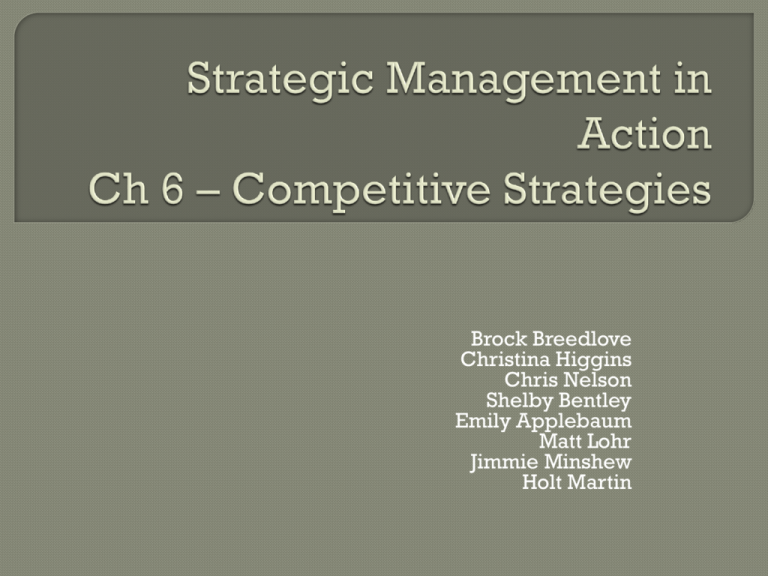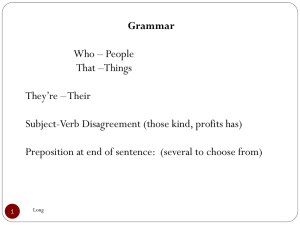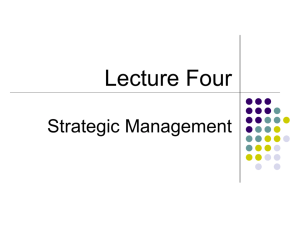Strategic Management in Action Ch 6 * Competitive Strategies
advertisement

Brock Breedlove Christina Higgins Chris Nelson Shelby Bentley Emily Applebaum Matt Lohr Jimmie Minshew Holt Martin What competitive advantage is and what it implies Description of the different competitive strategies How competitive strategies are implemented and evaluated It is what sets an organization apart from the competition Ex: Coke formula, Dell custom computers Distinct capability Unique resource To understand the competitive environment, we first have to understand what competition is and then look at who our competitors are. Competition: when organizations battle or vie for some desired object or outcome • For business organizations, that’s typically customers market share, survey ranking, or needed resources • FIN 3321 project • What competition might an organization face? We can answer this by looking at who the competitors are Competitors • Chapter 3: competitors are part of the specific environment • 3 approaches to defining an organization’s competition— industry, market share, strategic groups 3 approaches to defining an organization’s competition 1. Industry: identifies competitors as organizations that are making and selling the same or very similar goods or services Ex. Supermarket industry, automobile industry Can be described according to number of sellers and degree of differentiation, both of which affect the intensity of competition 2. Market: says competitors are organizations that satisfy the same customer needs. Ex. Entertainment- video games, movie theaters, Six Flags Intensity depends on how well customer’s needs are understood and how well different organizations are able to meet those needs 3. Strategic Groups: based on the idea that there are groups of firms competing within an industry that have similar strategies, resources, and customers In a single industry, may have few or several strategic groups, depending on what is important to customers (ex. Price, quality) Good way to define who competitors are because your most relevant competitors are those in your strategic groups Competition intensity depends on how effectively each competitor has developed its competitive advantage and on the competitive strategies each uses Some Home Depot Competitors • Lowe’s Company • Menards • CCA Global What is it that makes some organizations more successful than others? Why do some professional basketball teams consistently win championships or draw larges crowds? Why do some colleges, universities, or majors experience continually increasing enrollments? • Every organization most likely has the resources or capabilities it needs to be successful so why do some succeed over others? • All organizations in a certain industry want to be on top and strive to be better than competition. They do this based on the their competitive strategy. • As an organization refines and sharpens its competitive advantage, the basis for competitive strategy is established. • A company that displays a successful competitive strategy is Netflix. • Competitive strategy is based on competitive advantage: • Unique DVD rental and distribution service. Our competitive advantages position Netflix for long-term success in Internet delivery •Netflix is uniquely positioned to offer a hybrid service – Internet streaming and DVDs by mail, for one low price – giving our subscribers access to a broad content selection and offering a compelling value proposition. •We have built an iconic and widely admired brand that consumers have come to associate with an outstanding home entertainment experience. •We have a large and loyal subscriber base that loves us for our selection, recommendations, convenience and an excellent customer experience. (http://www.netflix.com/?mqso=80025 Top Music and Video Stores Companies by Market Cap $59,200,000 $40,080,000 $39,870,000 Netflix, Inc. Hastings Entertainment $3,690,000,00 0 Blockbuster Inc. Trans World Entertainment • • Miles and Snow’s Adaptive Strategies Porter’s Generic Competitive Strategies Based on the strategies organizations use to adapt to their uncertain competitive environments • Prospector • Defender • Analyzer • Reactor Continually innovates by finding and exploiting new product and market opportunities Blue Ocean Strategy Used to protect current market share by emphasizing existing products Red Ocean Strategy Watch and copy the successful ideas of prospectors Compete by following the direction that prospectors pioneer Lack coherent strategy, simple react to changes in the environment Lag behind competitors Weak competitive position Cost Leadership Differentiation Focus Tries to achieve lowest costs in its industry Produce products for broad customer base With lowest costs, it can charge lower prices • Detailed attention to • Strict adherence to efficiency at all levels • Little product line variations • Aim marketing at the “average” customer budgeting • Emphasize productivity • Lack lavish corporate headquarters Disadvantages: •Competitors can develop ways to leverage costs better •Easy to lose sight of changing customer needs by solely focusing on low-costs World’s largest home improvement chain • Offer wide range of products 2nd largest retailer in the US behind Wal-Mart In-Store Low Price Guarantee • Match any other retailers lowest price on an item in stock, and guarantee to beat it by up to 10% Compete by providing unique products • Usually higher prices Customers view product as different • Broad differentiator Customers willing to pay a premium • Costs are high, but prices are too • Aim all operations at understanding a specific market • Establish brand loyalty • Develop skilled R&D capabilities • Develop diverse product lines Disadvantages: •Without uniqueness, customers won’t pay premiums •Poor economic climate causing frugality Pursue cost or differentiation advantage through consumer limitations • Close relations with a limited market • Operate on small scale = higher costs (Disadvantage.) • Separate from broad differentiator & cost leader Focus on a narrow customer segment • 3 ways to segment consumer base: Geographical Customer Type Product Line Lowest costs in an overall industry in specific niches Produce custom built Product features, innovations, and quality are all specialized into one market segment. products “Buy High, Sell High” mentality to create culture of quality Contemporary Views: provide an expanded and more realistic description of the competitive strategies organizations are using. Two 1. 2. Kinds: Integrated Low Cost-Differentiated Strategy Mintzberg’s Generic Competitive Strategies A strategy that involves simultaneously achieving low costs and high levels of differentiation. Porter argued that a company could not simultaneously pursue a low cost and a differentiation strategy. He believed the result of pursuing both would lead to a company not fully developing either. However, research has showed it is possible to have a low cost and differentiation strategy (but it’s difficult) Succeeded in competitive market by innovating new products and keeping costs low. $1 breakfast menu Technology Widespread technology has made it easier for organizations to pursue product and service differentiation while still keeping costs low. just in time inventory systems, flexible manufacturing systems, integrated information systems Harry Mintzberg proposed six possible competitive strategies Research shows his ideas has merit , but will probably never replace the popularity of Porter’s competitive strategies Mintzberg’s Model By Price By Marketing Image Differentiation By Product Design By Product Quality Undifferentiated By Product Support By Price: Argued in opposition to Porter that having the lowest costs didn’t provide a competitive advantage in itself, but the advantage came from the fact that it allowed the organization to charge below-average prices. By Marketing Image: organization attempts to create image in customers’ minds By Product Design: organizations use desirable product features and design configurations By Product Quality: organizations deliver higher reliability and performance at a comparable price By Product Support: emphasized customer support services provided by the organization Organization has no basis for differentiation or follows a copycat strategy The competitive strategy can be seen by what’s actually being done or implemented. Strategy Implementation is crucial. • If the strategy is not implemented, it is nothing more than an idea. • Once a strategy is implemented, it must be assessed and modified as need. Having effective resources, capabilities, and core competencies in place. • These include employees, facilities and equipment, work activities and work systems • Having these effectively in place is the key successful implementation An organization’s functional strategies play a significant role in implementing competitive strategy. Create and exploit a sustainable competitive advantage. • Use resources and develop capabilities that may become distinctive. Functional Strategy plays a dual role • First, choose a competitive strategy based on a company’s resources and capabilities currently available • Second, the resources, capabilities, and competencies are how the strategy is implemented • Overall, the functional strategies being used should support whatever competitive advantage, and competitive strategy is being pursued. Using certain tactics to acquire or keep whatever object or outcome they are after • Offensive Moves - An organizations attempt to exploit and strengthen its competitive position through attacks on a competitor’s position • Defensive Movies - An organizations attempt to protect its competitive advantage and turf Monitoring & Evaluating Results? What Happened and Why? Changing vs. Modifying Competitive Strategy, Advantage, & Environment Different Strategies Implementing Strategies Evaluation of Strategy



